On the Bioconvective Aspect of Viscoelastic Micropolar Nanofluid Referring to Variable Thermal Conductivity and Thermo-Diffusion Characteristics
Abstract
1. Introduction
2. Flow Problem
3. Homotopy Analysis Method
4. Convergent Region and Solution Confirmations
5. Verification of Results
6. Analysis of Results
7. Conclusions
- The thermal profile decreases by increasing vortex viscosity parameters while the opposite behavior is visualized for the variable thermal conductivity parameter and thermophoresis parameter. Such a variation trend is more dominant for viscoelastic cases.
- The combined parameter and Dufour Lewis number progressively enlarge the heating and solutal concentration phenomena.
- The lower effects for volume fraction of nanofluid due to nano Lewis number are noted.
- The Nusselt quantity and Sherwood number declined for variable thermal conductivity parameters and thermophoresis parameters.
- The observations made here may play vital role for suggesting and improving manufacturing and diffusion processes.
Author Contributions
Funding
Institutional Review Board Statement
Informed Consent Statement
Data Availability Statement
Conflicts of Interest
Nomenclature
| velocity | |
| stretching constant constant | |
| combined parameter | |
| viscoelastic parameter | |
| thermophoresis parameter | |
| modified Dufour number | |
| Peclet number | |
| microorganism concentration difference | |
| nano Lewis number | |
| thermal dependence conductivity factor | |
| electrical conductivity | |
| stands for permeability of porous medium | |
| fluid density | |
| N | micro-rotation |
| Brownian diffusion coefficients | |
| solutal diffusivity | |
| Soret diffusivity | |
| concentration | |
| temperature | |
| vortex viscosity parameter | |
| Prandtl number | |
| Brownian motion parameter | |
| regular Lewis number | |
| Dufour Lewis number | |
| bioconvection Lewis | |
| fluid constant | |
| material conductivity | |
| viscoelastic parameter | |
| spin gradient viscosity | |
| j | microinertia per unit mass |
| thermal diffusivity | |
| Dufour diffusivity | |
| thermophoretic diffusion coefficient | |
| heat capacity of nanoparticles to heat capacity of fluid ratio. |
References
- Choi, S.U.S. Enhancing thermal conductivity of fluids with nanoparticles. Int. Mech. Eng. Cong. Exp. 1995, 99–105. [Google Scholar]
- Buongiorno, J. Convective Transport in Nanofluids. J. Heat Transfer. 2006, 128, 240–250. [Google Scholar] [CrossRef]
- Ramana Reddy, J.V.; Sugunamma, V.; Sandeep, N. Thermophoresis and Brownian motion effects on unsteady MHD nanofluid flow over a slendering stretching surface with slip effects. Alex. Eng. J. 2018, 57, 2465–2473. [Google Scholar] [CrossRef]
- Usman, M.; Soomro, F.A.; Haq, R.U.; Wang, W.; Defterli, O. Thermal and velocity slip effects on Casson nanofluid flow over an inclined permeable stretching cylinder via collocation method. Int. J. Heat Mass Transf. 2018, 122, 1255–1263. [Google Scholar] [CrossRef]
- Yin, C.; Zheng, L.; Zhang, C.; Zhang, X. Flow and heat transfer of nanofluids over a rotating disk with uniform stretching rate in the radial direction. Propuls. Power Res. 2017, 6, 25–30. [Google Scholar] [CrossRef]
- Madhu, M.; Kishan, N.; Chamkha, A.J. Unsteady flow of a Maxwell nanofluid over a stretching surface in the presence of magnetohydrodynamic and thermal radiation effects. Propuls. Power Res. 2017, 6, 31–40. [Google Scholar] [CrossRef]
- Turkyilmazoglu, M. Free and circular jets cooled by single phase nanofluids. Eur. J. Mech.-B/Fluids 2019, 76, 1–6. [Google Scholar] [CrossRef]
- Turkyilmazoglu, M. Buongiorno model in a nanofluid filled asymmetric channel fulfilling zero net particle flux at the walls. Int. J. Heat Mass Transf. 2018, 126, 974–979. [Google Scholar] [CrossRef]
- Abbasi, F.M.; Shanakhat, I.; Shehzad, S.A. Entropy generation analysis for peristalsis of nanofluid with temperature dependent viscosity and Hall effects. J. Magn. Magn. Mater. 2019, 474, 434–441. [Google Scholar] [CrossRef]
- Waqas, H.; Shehzad, S.A.; Khan, S.U.; Imran, M. Novel Numerical Computations on Flow of Nanoparticles in Porous Rotating Disk with Multiple Slip Effects and Microorganisms. J. Nanofluids 2019, 8, 1423–1432. [Google Scholar] [CrossRef]
- Sun, L.; Wang, G.; Zhang, C.; Jin, Q.; Song, Y. On the rheological properties of multi-walled carbon nano-polyvinylpyrrolidone/silicon-based shear thickening fluid. Nanotechnol. Rev. 2021, 10, 1339–1348. [Google Scholar] [CrossRef]
- Li, J.; Liang, Z.; Chen, Z.; Zhang, Z.; Liu, H.; Liu, Z.; Xu, Z. Engineering unsaturated sulfur site in three-dimension MoS2@rGO nanohybrids with expanded interlayer spacing and disordered structure for gaseous elemental mercury trap. Chem. Eng. J. 2023, 453, 139767. [Google Scholar] [CrossRef]
- Li, Z.; Zhang, Q.; Shen, H.; Xiao, X.; Kuai, H.; Zheng, J. Buckling performance of the encased functionally graded porous composite liner with polyhedral shapes reinforced by graphene platelets under external pressure. Thin-Walled Struct. 2023, 183, 110370. [Google Scholar] [CrossRef]
- Yang, Y.; Wang, S.; Wen, H.; Ye, T.; Chen, J.; Li, C.; Du, M. Nanoporous Gold Embedded ZIF Composite for Enhanced Electrochemical Nitrogen Fixation. Angew. Chem. Int. Ed. 2019, 58, 15362–15366. [Google Scholar] [CrossRef]
- Agarwal, S.; Rana, P. Analysis of periodic and aperiodic convective stability of double diffusive nanofluid convection in rotating porous layer. Appl. Math. Mech. 2016, 37, 215–226. [Google Scholar] [CrossRef]
- Raghunatha, K.R.; Shivakumara, I.S. Stability of triple diffusive convection in a viscoelastic fluid-saturated porous layer. Appl. Math. Mech. 2018, 39, 1385–1410. [Google Scholar] [CrossRef]
- Daba, M.; Devaraj, P. Unsteady double diffusive mixed convection flow over a vertically stretching sheet in the presence of suction/injection. J. Appl. Mech. Tech. Phys. 2017, 58, 232–243. [Google Scholar] [CrossRef]
- Gireesha, B.; Archana, M.; Prasannakumara, B.C.; Gorla, R.R.; Makinde, O.D. MHD three dimensional double diffusive flow of Casson nanofluid with buoyancy forces and nonlinear thermal radiation over a stretching surface. Int. J. Numer. Methods Heat Fluid Flow 2017, 27, 2858–2878. [Google Scholar] [CrossRef]
- Bilal, S.; Rehman, K.U.; Malik, M.; Hussain, A.; Awais, M. Effect logs of double diffusion on MHD Prandtl nano fluid adjacent to stretching surface by way of numerical approach. Results Phys. 2017, 7, 470–479. [Google Scholar] [CrossRef]
- Hayat, T.; Qayyum, S.; Shehzad, S.A.; Alsaedi, A. Cattaneo–Christov double-diffusion model for flow of Jeffrey fluid. J. Braz. Soc. Mech. Sci. Eng. 2017, 39, 4965–4971. [Google Scholar] [CrossRef]
- Irfan, M.; Khan, M.; Khan, W.A. On model for three-dimensional Carreau fluid flow with Cattaneo–Christov double diffusion and variable conductivity: A numerical approach. J. Braz. Soc. Mech. Sci. Eng. 2018, 40, 577. [Google Scholar] [CrossRef]
- Prasannakumara, B.; Reddy, M.G.; Thammanna, G.; Gireesha, B. MHD Double-diffusive boundary-layer flow of a Maxwell nanofluid over a bidirectional stretching sheet with Soret and Dufour effects in the presence of radiation. Nonlinear Eng. 2018, 7, 195–205. [Google Scholar] [CrossRef]
- Eringen, A.C. Microcontinuum Field Theories; Springer: New York, NY, USA, 2001; Volume I, II. [Google Scholar]
- Eringen, A.C. Simple micro fluids. Int. J. Eng. Sci. 1964, 2, 205–217. [Google Scholar] [CrossRef]
- Eringen, A.C. Theory of micropolar fluid. J. Math. Mech. 1966, 16, 1–18. [Google Scholar] [CrossRef]
- Eringen, A.C. Theory of thermomicro fluids. J. Math. Anal. Appl. 1972, 38, 480–496. [Google Scholar] [CrossRef]
- Nazeer, M.; Hussain, F.; Khan, M.I.; Khalid, K. Theoretical analysis of electrical double layer effects on the multiphase flow of Jeffrey fluid through a divergent channel with lubricated walls. Waves Random Complex Media 2022, 1–15. [Google Scholar] [CrossRef]
- Abbas, Z.; Sheikh, M.; Sajid, M. Hydromagnetic stagnation point flow of a micropolar viscoelastic fluid towards a stretching/shrinking sheet in the presence of heat generation. Can. J. Phys. 2014, 92, 1113–1123. [Google Scholar] [CrossRef]
- Turkyilmazoglu, M. Mixed convection flow of magnetohydrodynamic micropolar fluid due to a porous heated/cooled deformable plate: Exact solutions. Int. J. Heat Mass Transf. 2017, 106, 127–134. [Google Scholar] [CrossRef]
- Sui, J.; Zhao, P.; Cheng, Z.; Zheng, L.; Zhang, X. A novel investigation of a micropolar fluid characterized by nonlinear constitutive diffusion model in boundary layer flow and heat transfer. Phys. Fluids 2017, 29, 023105. [Google Scholar] [CrossRef]
- Sajid, M.; Sadiq, M.; Ali, N.; Javed, T. Numerical simulation for Homann flow of a micropolar fluid on a spiraling disk. Eur. J. Mech.-B/Fluids 2018, 72, 320–327. [Google Scholar] [CrossRef]
- Abdelmalek, Z.; Khan, S.U.; Awais, M.; Mustfa, M.S.; Tlili, I. Analysis of generalized micropolar nanofluid with swimming of microorganisms over an accelerated surface with activation energy. J. Therm. Anal. Calorim. 2020, 144, 1051–1063. [Google Scholar] [CrossRef]
- Turkyilmazoglu, M. Determination of the correct range of physical parameters in the approximate analytical solutions of nonlinear equations using the Adomian decomposition method. Mediterr. J. Math. 2016, 13, 4019–4037. [Google Scholar] [CrossRef]
- Liao, S.J. Advance in the Homotopy Analysis Method. 5 Toh Tuck Link; World Scientific Publishing: Singapore, 2014. [Google Scholar]
- Khan, S.; Ali, N.; Hayat, T. Analytical and Numerical Study of Diffusion of Chemically Reactive Species in Eyring-Powell Fluid over an Oscillatory Stretching Surface. Bulg. Chem. Commun. 2017, 49, 320–330. [Google Scholar]
- Khan, S.U.; Shehzad, S.A.; Ali, N. Interaction of magneto-nanoparticles in Williamson fluid flow over convective oscillatory moving surface. J. Braz. Soc. Mech. Sci. Eng. 2018, 40, 195. [Google Scholar] [CrossRef]
- Turkyilmazoglu, M. The analytical solution of mixed convection heat transfer and fluid flow of a MHD viscoelastic fluid over a permeable stretching surface. Int. J. Mech. Sci. 2013, 77, 263–268. [Google Scholar] [CrossRef]
- El-Kabeir, S. Hiemenz flow of a micropolar viscoelastic fluid in hydromagnetics. Can. J. Phys. 2005, 83, 1007–1017. [Google Scholar] [CrossRef]
- Shi, M.; Zhu, H.; Chen, C.; Jiang, J.; Zhao, L.; Yan, C. Synergistically coupling of graphene quantum dots with Zn-intercalated MnO2 cathode for high-performance aqueous Zn-ion batteries. Int. J. Miner. Met. Mater. 2022, 30, 25–32. [Google Scholar] [CrossRef]
- Feng, X.; Jiang, L.; Li, D.; Tian, S.; Zhu, X.; Wang, H.; He, C.; Li, K. Progress and key challenges in catalytic combustion of lean methane. J. Energy Chem. 2022, 75, 173–215. [Google Scholar] [CrossRef]
- Huang, Z.; Li, T.; Huang, K.; Ke, H.; Lin, M.; Wang, Q. Predictions of flow and temperature fields in a T-junction based on dynamic mode decomposition and deep learning. Energy 2022, 261, 125228. [Google Scholar] [CrossRef]
- Yang, J.; Fu, L.-Y.; Zhang, Y.; Han, T. Temperature- and Pressure-Dependent Pore Microstructures Using Static and Dynamic Moduli and Their Correlation. Rock Mech. Rock Eng. 2022, 55, 4073–4092. [Google Scholar] [CrossRef]
- Xiao, D.; Hu, Y.; Wang, Y.; Deng, H.; Zhang, J.; Tang, B.; Xi, J.; Tang, S.; Li, G. Wellbore cooling and heat energy utilization method for deep shale gas horizontal well drilling. Appl. Therm. Eng. 2022, 213, 118684. [Google Scholar] [CrossRef]
- Chu, Y.-M.; Khan, M.I.; Abbas, T.; Sidi, M.O.; Alharbi, K.A.M.; Alqsair, U.F.; Khan, S.U.; Malik, M. Radiative thermal analysis for four types of hybrid nanoparticles subject to non-uniform heat source: Keller box numerical approach. Case Stud. Therm. Eng. 2022, 40, 102474. [Google Scholar] [CrossRef]
- Bafakeeh, O.T.; Raza, A.; Khan, S.U.; Khan, M.I.; Nasr, A.; Ben Khedher, N.; Tag-Eldin, E.S.M. Physical Interpretation of Nanofluid (Copper Oxide and Silver) with Slip and Mixed Convection Effects: Applications of Fractional Derivatives. Appl. Sci. 2022, 12, 10860. [Google Scholar] [CrossRef]
- Ali, Q.; Al-Khaled, K.; Omar, J.; Raza, A.; Khan, S.U.; Khan, M.I.; Najati, S.A.; Oreijah, M.; Guedri, K.; Galal, A.M. Analysis for advection–diffusion problem subject to memory effects and local and nonlocal kernels: A fractional operators approach. Int. J. Mod. Phys. B 2022, 2350099. [Google Scholar] [CrossRef]
- Ali, Q.; Al-Khaled, K.; Khan, M.I.; Khan, S.U.; Raza, A.; Oreijah, M.; Guedri, K. Diffusion phenomenon for natural convection flow of classical Hartmann problem due to a cylindrical tube by generalized Fourier’s theories: A Fractional analysis. Int. J. Mod. Phys. B 2022, 2350104. [Google Scholar] [CrossRef]
- Harshavardhan, A.; Matt, S.B.; Khan, M.I.; Prakash, K.K.; Alnuwaiser, M.A.; Betageri, V.S.; Sidlinganahalli, M. Synthesis of Tin oxide nanoparticles using Nelumbo nucifera leaves extract for electrochemical sensing of dopamine. Int. J. Mod. Phys. B 2022. [Google Scholar] [CrossRef]
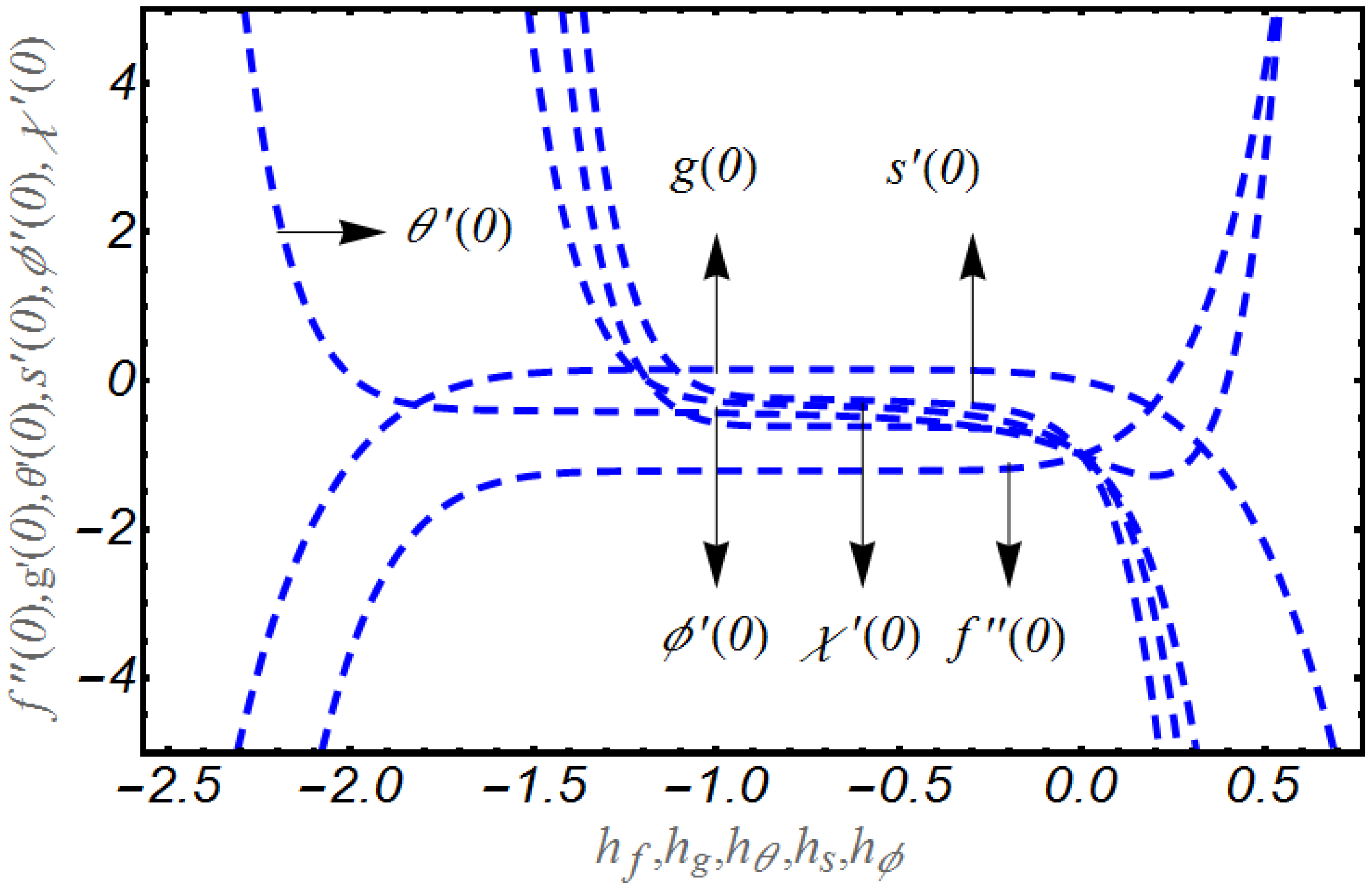

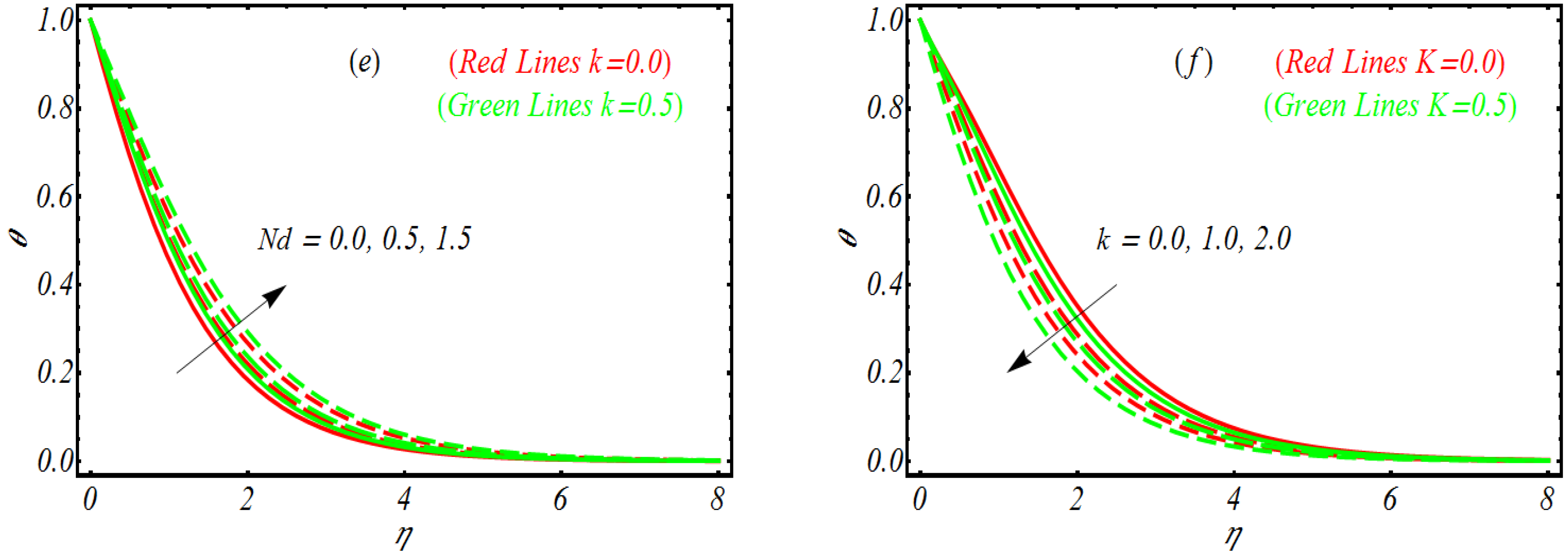


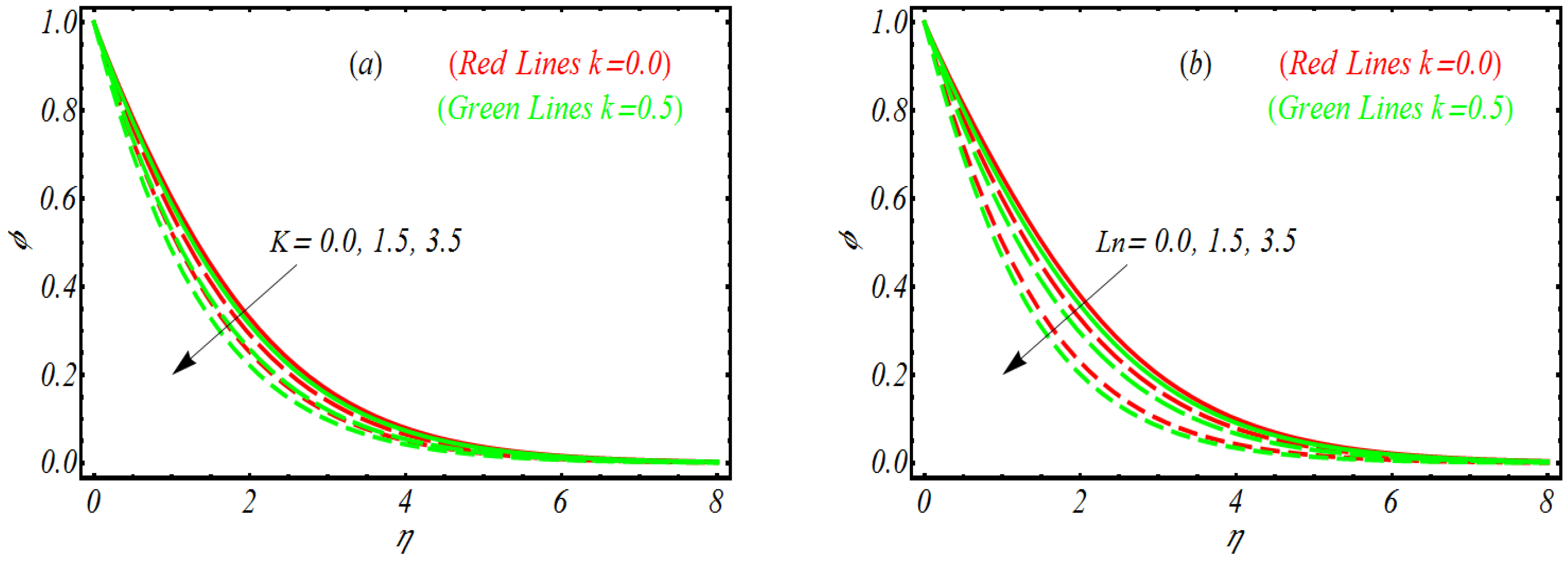
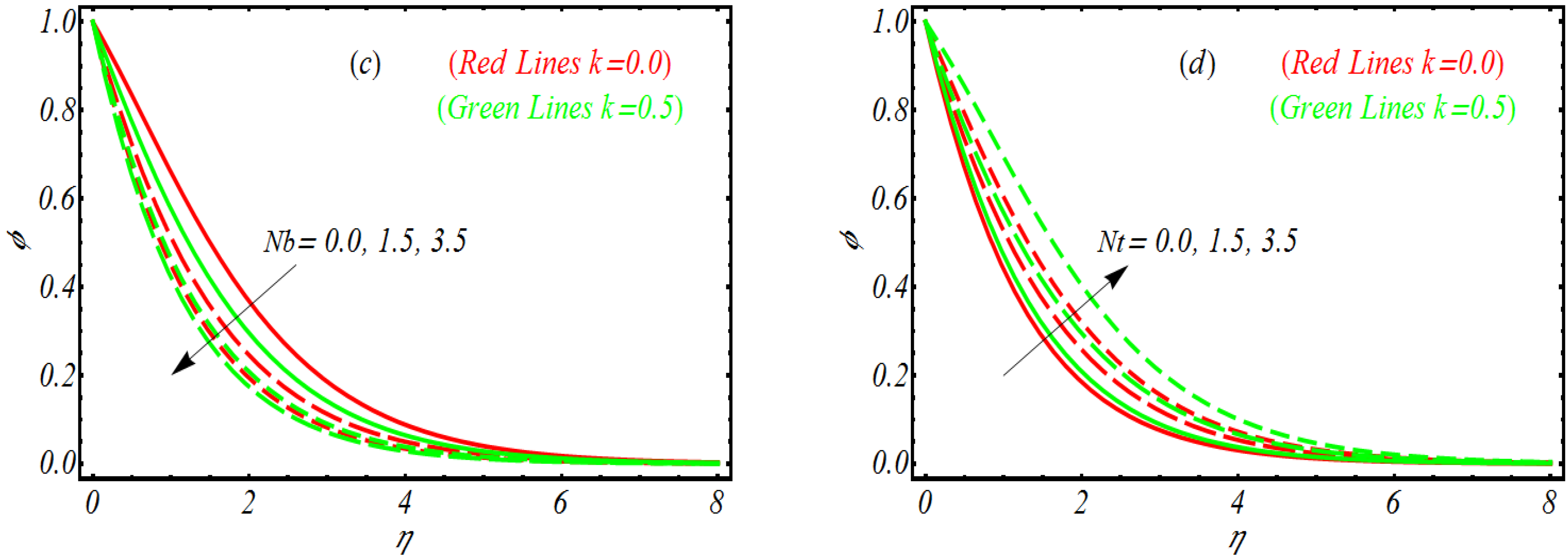
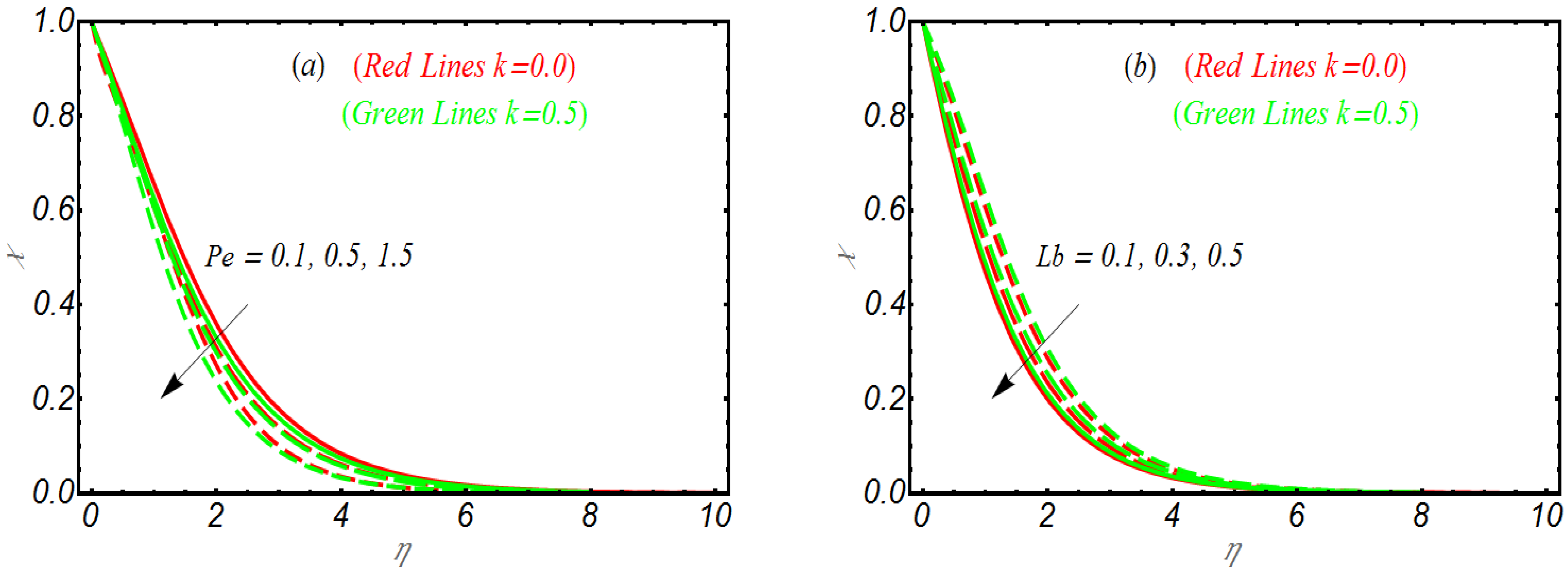
| Approximation Solutions | Auxiliary Parameters | Convergence Region |
|---|---|---|
| El-Kabeir [38] | Present Results | |
|---|---|---|
| 0.2 | 1.24857 | 1.24856 |
| 0.4 | 1.29537 | 1.29535 |
| 0.6 | 1.36988 | 1.36980 |
| 0.1 0.3 0.7 | 0.2 | 0.763453 0.810542 0.845234 | 0.0542344 0.0585465 0.0621414 |
| 0.2 | 0.3 0.5 0.7 | 0.78522 0.823455 0.893443 | 0.042234 0.051355 0.5579554 |
| 0.0 0.5 1.0 | 0.7 | 0.3 | 0.3 | 0.1 | 0.1 | 0.67456 0.63345 0.60945 | 0.52678 0.48635 0.44743 | 0.5056578 0.46658 0.43665 |
| 0.5 | 0.2 0.7 1.0 | 0.433435 0.48467 0.510535 | 0.464367 0.51046 0.54426 | 0.46065 0.48456 0.49547 | ||||
| 0.7 | 0.0 0.3 0.5 | 0.432345 0.4165 0.3978 | 0.550768 0.50235 0.46436 | 0.452075 0.43867 0.40655 | ||||
| 0.3 | 0.1 0.3 0.6 | 0.49361 0.45546 0.43436 | 0.54646 0.58643 0.60266 | 0.4568 0.49846 0.51754 | ||||
| 0.0 0.3 0.6 | 0.440241 0.43656 0.40567 | 0.492345 0.46654 0.43742 | 0.4345456 0.4054545 0.391123 | |||||
| 0.1 | 0.0 0.4 0.7 | 0.4437 0.5159 0.53755 | 0.50436 0.53576 0.56747 | 0.50423 0.53366 0.570547 |
Disclaimer/Publisher’s Note: The statements, opinions and data contained in all publications are solely those of the individual author(s) and contributor(s) and not of MDPI and/or the editor(s). MDPI and/or the editor(s) disclaim responsibility for any injury to people or property resulting from any ideas, methods, instructions or products referred to in the content. |
© 2023 by the authors. Licensee MDPI, Basel, Switzerland. This article is an open access article distributed under the terms and conditions of the Creative Commons Attribution (CC BY) license (https://creativecommons.org/licenses/by/4.0/).
Share and Cite
Bafakeeh, O.T.; Al-Khaled, K.; Khan, S.U.; Abbasi, A.; Ganteda, C.; Khan, M.I.; Guedri, K.; Eldin, S.M. On the Bioconvective Aspect of Viscoelastic Micropolar Nanofluid Referring to Variable Thermal Conductivity and Thermo-Diffusion Characteristics. Bioengineering 2023, 10, 73. https://doi.org/10.3390/bioengineering10010073
Bafakeeh OT, Al-Khaled K, Khan SU, Abbasi A, Ganteda C, Khan MI, Guedri K, Eldin SM. On the Bioconvective Aspect of Viscoelastic Micropolar Nanofluid Referring to Variable Thermal Conductivity and Thermo-Diffusion Characteristics. Bioengineering. 2023; 10(1):73. https://doi.org/10.3390/bioengineering10010073
Chicago/Turabian StyleBafakeeh, Omar T., Kamel Al-Khaled, Sami Ullah Khan, Aamar Abbasi, Charankumar Ganteda, M. Ijaz Khan, Kamel Guedri, and Sayed M. Eldin. 2023. "On the Bioconvective Aspect of Viscoelastic Micropolar Nanofluid Referring to Variable Thermal Conductivity and Thermo-Diffusion Characteristics" Bioengineering 10, no. 1: 73. https://doi.org/10.3390/bioengineering10010073
APA StyleBafakeeh, O. T., Al-Khaled, K., Khan, S. U., Abbasi, A., Ganteda, C., Khan, M. I., Guedri, K., & Eldin, S. M. (2023). On the Bioconvective Aspect of Viscoelastic Micropolar Nanofluid Referring to Variable Thermal Conductivity and Thermo-Diffusion Characteristics. Bioengineering, 10(1), 73. https://doi.org/10.3390/bioengineering10010073








